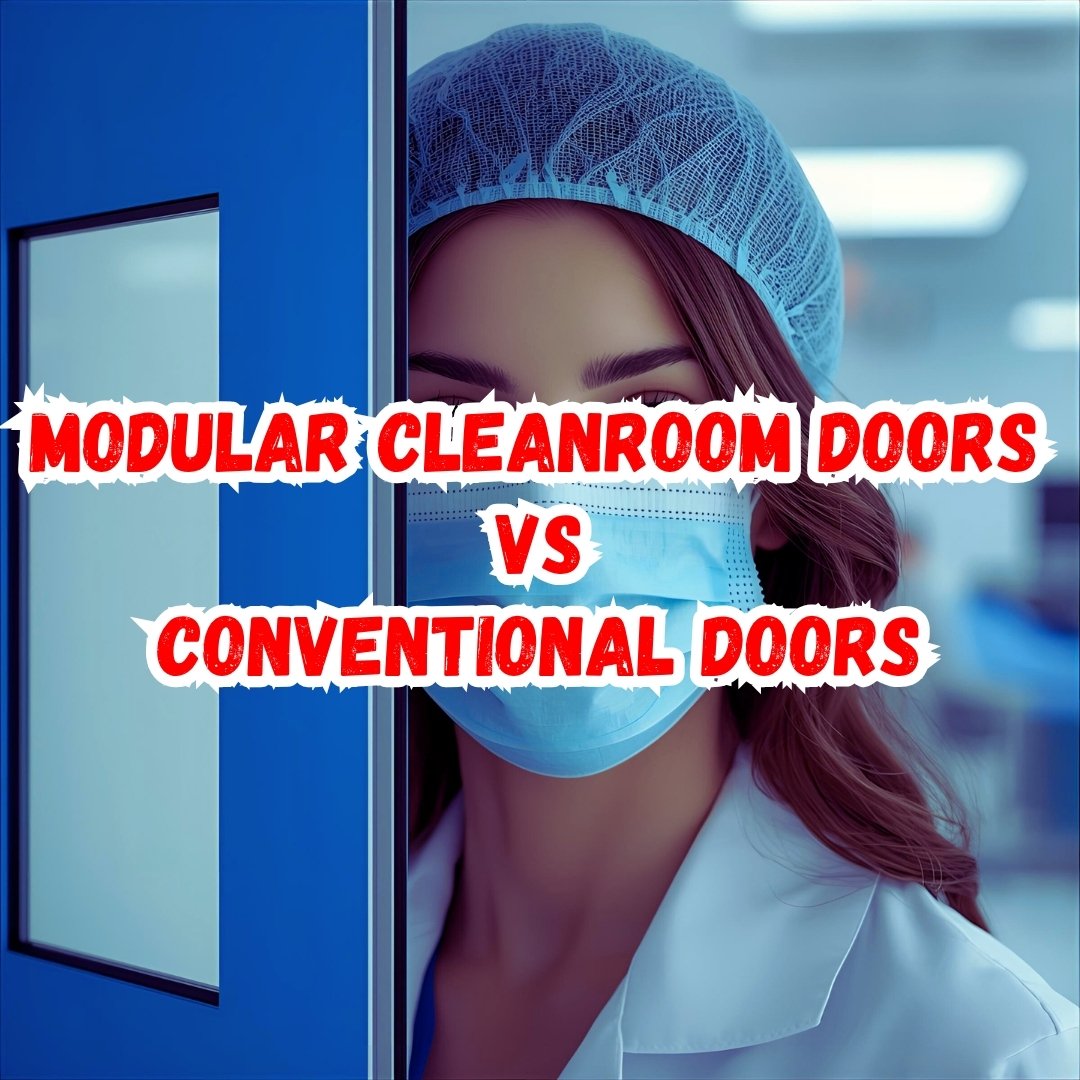
Walk through any new hospital in Ahmedabad or a pharma plant in Gujarat, and you’ll notice something: the walls, ceilings, and even the Operation Theater Doors aren’t being built the old way anymore. No cement dust, no brickwork, no months of plastering and painting. Instead, entire sterile spaces are being assembled like precision machines — with prefabricated PUF panels, Cleanroom Doors, and factory-engineered components.
This shift isn’t a fad. It’s a deliberate move toward modular cleanroom systems that promise faster completion, tighter hygiene control, and easier compliance with NABH, WHO, and GMP standards. Civil construction, with its unpredictable delays and messy execution, is being quietly replaced by modular precision.
Let’s look closely at why that’s happening — and what it means for hospitals, pharma facilities, and cleanroom infrastructure projects across India.
The Limitations of Traditional Civil Construction
Traditional methods once defined hospital and pharma infrastructure. Brick-and-mortar walls, plastered finishes, manual sealing, and hand-built service cutouts were the norm. But this approach now struggles to keep up with modern performance and regulatory expectations.
Here’s why:
- Time overruns are inevitable: Construction teams depend on multiple trades — civil, electrical, mechanical, HVAC, painting — all working in sequence. Even a minor delay in one trade snowballs across the project. Hospitals can’t afford that downtime when they need to operationalize ICUs or OTs fast.
- Cleanliness during construction is poor: Civil work generates dust, debris, and micro-cracks — the opposite of what a controlled environment requires. Even after completion, sealing such imperfections is difficult, raising the risk of microbial contamination.
- Retrofitting is painful: Adding a new door, pipe, or duct means breaking into finished walls, disrupting services, and exposing sterile zones. In regulated facilities, that often triggers fresh validation cycles and audits.
- Inconsistent quality control: Site-built finishes depend heavily on local labour skill and supervision. Variations in plastering, painting, or sealing quality can fail NABH or GMP audits.
- Lifecycle maintenance is expensive: When a wall or ceiling needs repair, the entire zone may need to be isolated and rebuilt. Every shutdown means lost production time or cancelled procedures.
For a hospital’s operation theatre, a diagnostic lab, or a pharma production unit, those risks aren’t acceptable anymore.
Modular Cleanrooms: What They Really Are
A modular cleanroom isn’t just a prefab room. It’s a coordinated system made up of pre-engineered wall and ceiling panels, Cleanroom Flush Doors, viewing panels, and integrated service cutouts. These components are fabricated in controlled factory environments and assembled on-site with minimal dust or disruption.
The panels typically use PUF insulation (Polyurethane Foam) sandwiched between steel sheets, delivering both thermal efficiency and cleanability. Doors, like Hermetical Doors or PUF Insulated Doors, are precision-fitted into these panels to maintain airtight performance and hygiene.
The result? A faster, cleaner, more compliant environment ready for validation far sooner than civil construction can achieve.
You can read about such modular configurations in Cleanroom Solutions.
Ten Reasons Modular Cleanrooms Are Replacing Traditional Construction
1. Speed of Installation
With panels, doors, and accessories prefabricated, the site becomes a place for assembly — not construction. There’s no drying time for plaster, no curing, no on-site painting.
A medium-sized operation theatre that might take 12–16 weeks through civil work can be completed in less than half that time with modular installation. For hospital expansions or pharma upgrades, this speed is critical.
2. Predictable Quality and Costs
Every modular component is made under consistent factory conditions, minimizing workmanship errors. That predictability ensures precise alignment between PUF Insulated Doors, wall panels, and ceiling modules.
Costs become more stable too. You know exactly how much material, labour, and time will be needed — a rarity in civil projects.
Learn more about factory-made door systems on our PUF Insulated Doors page.
3. Hygiene and Contamination Control
Cleanrooms are only as sterile as their smallest joint. Modular panels have sealed, flush surfaces with seamless junctions between wall, ceiling, and door frames. Civil-built walls, in contrast, have joints, edges, and paint layers that can crack or peel.
In a modular OT or ICU setup, Cleanroom Doors and Hermetical Doors are designed to sit perfectly within the panels, leaving no gaps for dust or microbial accumulation. This airtightness simplifies NABH and GMP compliance.
The NABH guidelines themselves stress the importance of cleanable, non-porous finishes for critical hospital areas — something modular systems achieve far more reliably.
4. Flexible and Scalable
Hospitals and pharma plants evolve. An IVF centre may expand, or a diagnostic lab might add new equipment that demands different room zoning. Modular systems can adapt — panels and door modules can be reconfigured, extended, or replaced without major structural changes.
This flexibility is what makes modular setups ideal for Turnkey Projects and ICU Setup expansions where long-term adaptability is key.
You can see how modularity supports future-ready design in our Turnkey Projects section.
5. Easy Maintenance and Repair
In traditional construction, repairing or replacing a damaged section often means demolition. In modular systems, individual panels or Cleanroom Doors can be removed and replaced without disturbing adjacent structures.
That reduces downtime — essential in OTs or pharma zones where every hour counts.
6. Integration with HVAC and HEPA Filtration
Modular systems are engineered alongside HVAC designs, with dedicated cutouts for ducts, filters, and lighting. There’s no random chiselling of walls to fit new ducts.
This coordination ensures proper airflow patterns, pressure differentials, and particulate control — exactly what NABH and WHO standards demand. (World Health Organization)
7. Consistent Aesthetics and Functionality
Beyond compliance, modular cleanrooms simply look better. Surfaces remain smooth, uniform, and easy to clean. When paired with Operation Theater Doors or ICU Doors featuring flush designs and vision panels, the space communicates both hygiene and professionalism.
Check the Operation Theatre Doors catalogue for reference designs that fit modular systems seamlessly.
8. Compliance Documentation
Regulatory audits now demand traceability — from materials used to installation procedures. Modular manufacturers maintain production records, factory test certificates, and installation drawings, making compliance easier for project consultants and QA/QC teams.
This aligns perfectly with Ministry of Health & Family Welfare directives on traceability and accountability in healthcare infrastructure projects.
9. Energy Efficiency
PUF panels and sealed door systems minimize air leakage and thermal loss. That reduces HVAC energy consumption, which forms a large chunk of operational cost in clean environments.
Tighter envelopes also protect HEPA filters from overloading, extending their life and saving replacement costs.
Learn more about energy-efficient doors in Hospitals & Surgical Centres.
10. Sustainability and Waste Reduction
Every piece in a modular system is pre-engineered, meaning minimal waste at the site. When a facility is upgraded or relocated, many components — panels, PUF Insulated Doors, view panels — can be reused.
This reuse reduces demolition debris, conserves resources, and fits the sustainability commitments that many hospital chains and pharmaceutical companies are now adopting.
Modular Cleanrooms vs. Traditional Civil Construction: A Clear Comparison
| Criteria | Traditional Civil Construction | Modular Cleanroom Construction |
|---|---|---|
| Project Duration | 4–6 months typical | 1–2 months typical |
| Quality Control | Depends on on-site labour | Factory-tested, consistent |
| Cleanliness | Dust, cracks, paint layers | Seamless, flush, sterile |
| Flexibility | Difficult to modify | Panels and doors reconfigurable |
| HVAC Integration | Often afterthought | Pre-planned in design |
| Validation Readiness | Time-consuming | Faster commissioning |
| Maintenance | Disruptive repairs | Replaceable panels/doors |
| Energy Efficiency | Moderate | High, with airtight systems |
The Local Shift: Why Ahmedabad and Gujarat Are Embracing Modular Cleanrooms
Gujarat’s healthcare and pharmaceutical sectors are booming. Ahmedabad alone houses dozens of NABH-accredited hospitals and a growing number of pharmaceutical production units. Speed, compliance, and reliability matter more than ever.
Hospitals can’t afford year-long construction cycles for new ICUs or OTs. Modular construction allows them to go live faster, maintain sterility, and scale later without operational disruption.
Being a Operation Theater Door Manufacturer in Ahmedabad and ICU Door Manufacturer in Gujarat offers strategic proximity to this growing demand. Local partnerships mean faster delivery, easier after-sales support, and compliance with regional regulations.
The same holds true for pharma and R&D labs. With modular Pharma Doors and Cleanroom Flush Doors, local manufacturers can serve these high-spec environments quickly and reliably.
Visit Pharmaceuticals to see how modular cleanroom components are transforming GMP facilities.
How Modular Cleanrooms Improve Hospital Safety and Compliance
In India, NABH and WHO both outline clear requirements for sterile areas: smooth, seamless, washable surfaces; proper airflow; and minimal particle generation. Modular cleanrooms tick every one of these boxes.
- Walls and doors: Non-porous and easy to clean.
- Air handling: Designed with precise HEPA filtration and differential pressures.
- Materials: Non-shedding, corrosion-resistant, and validated for hospital use.
The integration of Hermetical Doors, Emergency Exit Doors, and Fire Exit Doors within modular designs also ensures safe evacuation routes and proper fire segregation.
See examples on Fire Exit Doors.
Practical Benefits for Hospitals, Labs, and Pharma Units
- Hospitals – Quicker commissioning of new OTs and ICUs; minimal disruption to running facilities.
- Diagnostic Labs – Rapid setup of sample processing and testing areas without contamination risk.
- Pharma Units – Easier GMP validation and batch segregation.
- Food & Beverage Plants – Modular systems with PUF Panels simplify hygiene zoning. (Food & Beverages)
- Electronics & Semiconductor Units – Dust-free assembly zones using Cleanroom Solutions. (Electronics & Semiconductors)
FAQs
1. Are modular cleanrooms durable enough for long-term hospital use?
Yes. High-quality modular systems with steel or aluminium facings and PUF cores can last decades if maintained properly.
2. Can modular cleanrooms achieve NABH or GMP certification?
Absolutely. As long as the system design, installation, and documentation meet standards, certification is straightforward.
3. Can modular cleanrooms be customized for any size or layout?
Yes. Modular systems can be designed for anything from a small IVF lab to a large multi-OT hospital block.
4. Are modular systems more expensive initially?
Sometimes slightly, but total lifecycle cost is lower due to shorter timelines, reduced downtime, and reusability.
5. What materials are used in modular cleanroom panels?
Commonly PUF, PIR, or mineral wool insulation with steel or aluminium facings, selected based on fire rating and hygiene requirements.
6. How do modular cleanrooms handle fire safety?
By incorporating Fire Exit Doors and fire-rated panels that comply with safety norms, allowing safe evacuation routes.
7. Can modular cleanrooms be relocated?
Yes. Panels and door modules can be dismantled and reinstalled at a new location, saving major reconstruction costs.
8. Are modular cleanrooms suitable for tropical climates like Gujarat?
Yes. PUF insulation provides excellent thermal stability, keeping interiors consistent despite external heat or humidity.
Conclusion
The cleanroom industry is evolving rapidly. Civil construction had its time, but modular systems are redefining what’s possible — faster installation, airtight hygiene, lower energy use, and flexible reconfiguration.
For hospitals, pharma units, and laboratories, modular construction isn’t just convenient; it’s becoming essential for NABH, GMP, and WHO compliance.
For manufacturers, the opportunity lies in integration. Whether you supply Operation Theater Doors, ICU Doors, PUF Insulated Doors, or Cleanroom Doors, your products sit at the core of this transformation.
AUM Industries, based in Ahmedabad, delivers turnkey cleanroom solutions, modular OT setups, and custom PUF panel doors designed to meet the highest hygiene and performance standards. Their focus on precision manufacturing and compliance makes them a trusted partner for modern healthcare and pharma projects across India.
To discuss your next modular OT, ICU, or cleanroom project, reach out to AUM Industries or visit operationtheaterdoors.com.






